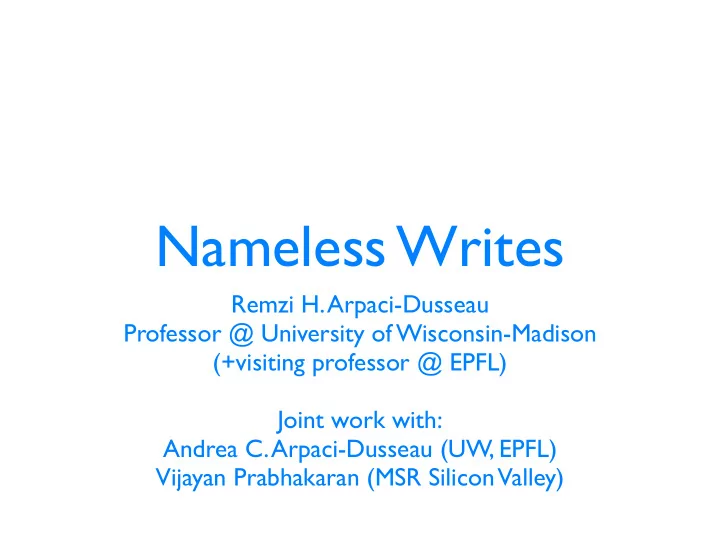

Nameless Writes Remzi H. Arpaci-Dusseau Professor @ University of Wisconsin-Madison (+visiting professor @ EPFL) Joint work with: Andrea C. Arpaci-Dusseau (UW, EPFL) Vijayan Prabhakaran (MSR Silicon Valley)
Indirection “All problems in computer science can be solved by another level of indirection” - usually attributed to Butler Lampson
Example: Virtual Memory Virtual Address Space Physical Memory code stack Page Table code heap heap code V PFN heap 1 2 code 1 3 heap 1 1 1 4 0 - stack 0 - 0 - 0 - 0 - 0 - 0 - 0 - 0 - 0 - 1 0 1 6 stack stack Problems? • Too big , too slow
Another example: RAID Early RAIDs: Simple indirection 0 1 2 3 4 5 6 7 • Fixed mapping avoids need for indirection table Mirrored 1 1 0 0 More sophisticated RAID, 7 7 6 6 more sophisticated mappings RAID • e.g., AutoRAID 4 5 2 P
Too Much of a Good Thing?
Virtual Machine Monitors VMMs: Another layer, beneath OS • Consolidation, multi-platform support, many other reasons But the cost of indirection grows Example: Virtual Memory (again) • Double Indirection: Virtual to Physical to Machine
Many Examples VMMs and Memory File System and RAID File System and Disk (a little) File System and RAID and Disk File System and Flash FTL
Today’s Focus: Flash
Flash FTL Flash Translation Layer (FTL) • Turns read-erase/program into read-write • Allows for wear leveling
Background page page page Flash organized into blocks block page page Each block contains some pages page page Problem: page • To program a page, must erase block first • Even worse: Erase is costly (ms not us) Implication: Simple mapping performs poorly • Would turn each write into erase/program
Solution: Use Indirection Solution: Borrow log-structuring ideas • Organize flash into a log • Erase an “active” block • Direct all writes to active block • Record mapping in indirection table (i-table)
Useful for Wear Too Wear-leveling problem • Too many erase-program cycles will render block unreadable (can’t differentiate ones from zeroes) Indirection helps here too • Balance write load across blocks • Might have to migrate blocks from live but not-often-used block for leveling
Problems
Cost of Indirection Too big • i-table (naive): one mapping per page • i-table (hybrid): one per page for some, one per block for most • Either way: MB (or GB) of memory , just for mapping information Too slow • Could be a problem too (if i-table doesn’t fit in memory)
So What Can We Do?
Key Idea: Turn Double Indirection To Our Advantage
Leverage: Double Indirection inode inode Double indirection example 0: 100 0: 8000 1: 101 1: 9500 • FS: virtual offset (in file) to logical block (on dev) SSD SSD • Flash: logical block to 100: 8000 no mapping 101: 9500 info needed physical page Can we remove one level of the indirection? • Generically called de-indirection
Our “Solution”: Nameless Writes
Nameless Writes Usual interface: • write(address, data): return OK/FAIL Nameless interface • write(data): return address, OK/FAIL Device chooses where to write block, and returns physical address to client (FS)
Simple Example Structures dirtied: inode (I), data (D) Usual approach • D is allocated to address A(D) • I is at fixed location [A(D) inside] • Write them out whenever (depending on FS) Nameless approach • Nameless write of D, returns A(D) • Update inode I with A(D)
What About Wear? Problem: Wear-leveling • Wear-leveling algorithm still might need to move blocks Solution: Renaming callback • Device upcalls into client, informs that device has moved block at address X to new location: addressY • Client (FS) must take action as needed
Key Features Removes FTL indirection • No more indirection table; assumed that client tracks locations Device retains control • For performance, still log-structured • For reliability, still does wear leveling
But, Lots of Problems File system must delay allocation decision File system must be able to write out blocks in certain order File system must be able to handle callback Sometimes need a “known location” Device must be willing to expose its physical nature (many more; your thoughts/complaints go here)
Other Ways To Do This? Could remove FTL (“file-system only”) • Buggy FS might do poor wear leveling • Device is better at managing its detailed performance characteristics Could do it in device (“device only”) • Hard to do while device is mounted Could consider alternate interfaces • e.g., inform device of pointers
Conclusions
Nameless Writes Addresses overheads of FTL indirection • Enables little or no mapping info • Device controls low-level decisions But, some pain points • Integrating into existing/new file systems • Will devices expose physical names? General approach of de-indirection • Likely more widely applicable
Indirection: Reprise “All problems in computer science can be solved by another level of indirection” - usually attributed to Butler Lampson Lampson attributes it to David Wheeler And Wheeler usually added: “but that usually will create another problem”
Recommend
More recommend